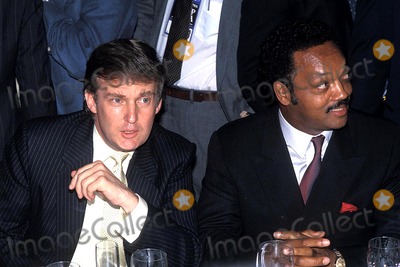Over the past two decades he was a Republican, then an independent, then a Democrat, then a Republican.
Which side is Donald Trump on?
Trump once endorsed a massive surtax on the rich. But he now wants the top income tax rate cut in half.
He opposed the war in Iraq, but says he now has a “foolproof” plan to defeat ISIL.
He’s praised single-payer health care, yet loathes Obamacare. But a decade ago he proposed “health marts” that sound suspiciously like today’s Obamacare exchanges.
 |
| The Boys Night out: Trump and Jesse Jackson |
Over the past two decades he was a Republican, then an independent, then a Democrat, then a Republican. Now, registered as an independent, he leads the Republican 2016 presidential field.
But what does Donald Trump really believe on policy? It’s hard to tell — his campaign will identify no policy director, he has no “issues” tab on his campaign website and he hasn’t given any substantive policy speeches on the campaign trail.
“His hair has been more permanent than his political positions,” said Thomas P. Miller, a health care policy expert at the conservative American Enterprise Institute. “It’s a total random assortment of whatever plays publicly.”
Voters are drawn to Trump more for his I’ll-say-anything style than for his policy views. But a close inspection of Trump’s two published policy tomes, “The America We Deserve” (2000) and “Time To Get Tough” (2011), along with Trump’s public statements in interviews, on Twitter and in public appearances, indicate that Trump’s policy preferences are eclectic, improvisational and often contradictory.
Some of his policy stances are flatout disqualifying to the Republican establishment, but that doesn’t seem to matter. The inconsistencies may even be an asset in assembling a coalition.
To a large extent Trump’s policy contradictions reflect his rapidly shifting political alliances over the past 15 years.
In 1999, Trump quit the Republican Party, saying “I just believe the Republicans are just too crazy right.” Trump was then conferring with political consultant Roger Stone about a possible presidential run as a candidate of the Reform Party, the political organization founded by his fellow billionaire Ross Perot.
In 2001, Trump quit the Reform Party to register as a Democrat. “It just seems that the economy does better under Democrats,” he told CNN’s Wolf Blitzer in 2004. The Clintons attended Trump’s Palm Beach wedding to former model Melania Knaus in 2005. The following year Trump gave $26,000 to the House and Senate campaign committees.
By the late aughts, though, Trump’s political giving had started shifting back to the GOP, and in 2009 Trump registered again as a Republican. Two years later he registered as an independent while contemplating a third-party bid.
It was during Trump’s leftward drift in 1999 that he first proposed a wealth tax — a one-time 14.25 percent levy on fortunes more than $10 million that inequality guru Thomas Piketty might salivate over. “The concept of a one-time tax on the super-wealthy is something he feels strongly about,” Stone told the Los Angeles Times.Read the rest of the story HERE.
If you like what you see, please "Like" us on Facebook either here or here. Please follow us on Twitter here.







No comments:
Post a Comment